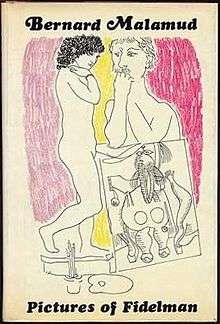Pictures of Fidelman
 First edition cover | |
| Author | Bernard Malamud |
|---|---|
| Cover artist | Catherine Smolich[1] |
| Country | United States |
| Language | English |
| Publisher | Farrar, Straus and Giroux |
Publication date | 1969 |
| Media type | |
| Pages | 208 pp |
| ISBN | 0-374-23248-2 |
| Preceded by | The Fixer (1966) |
| Followed by | The Tenants (1971) |
Pictures of Fidelman: An Exhibition is the fifth published novel of Bernard Malamud. It is a novel in the form of a short story cycle, which gathers six stories dealing with Arthur Fidelman, an art student from the Bronx who travels to Italy, initially to research Giotto, but also with the hopes of becoming a painter. It was published in 1969 and includes stories from Malamud's earlier collections The Magic Barrel (1958) and Idiots First (1963), plus two previously uncollected stories and one previously unpublished story.
Background
The novel consists of six linked stories. As Malamud's official biographer, Philip Davis, points out: "The first three of the six stories in Fidelman had been published previously: "The Last Mohican" in The Magic Barrel (1958), and "Still Life’" and "Naked Nude" in Idiots First (1963); "A Pimp’s Revenge" was published in Playboy and "Pictures of The Artist" in The Atlantic, both in 1968.[2]
Malamud had already published two collections of short stories by the time he gathered these stories together for a book. But his intention here was not to publish a third short story collection:
"Malamud insisted nonetheless that from the second story onwards he had intended it to be a separate book—but a looser work, written occasionally, to make a picaresque comedy freed of the pressures of a continuous life or single-minded career. Malamud particularly liked [a] Robert Scholes piece in Saturday Review of 10 May 1969, where the stories were described as ‘six comic Stations of the Cross’. As Malamud told his audience in some notes for a reading: ‘At first I thought they could be unrelated stories, each vertical, no horizontal bonds, but soon I conceived the content of the last story of the series and before long the thrust was diagonal as well as vertical."[2]
The Stories
Aside from Arthur Fidelman, the only character that appears in more than one story is Bessie, his sister, a mother of five living in Levittown, who occasionally sends him money.
"The Last Mohican"
First published in The Magic Barrel; Fidelman arrives in Italy and is repeatedly accosted by Shimon Susskind, "a Jewish refugee from Israel."
"Still Life"
First published in the Winter 1962 Partisan Review and later included in Idiots First; Fidelman moves into a studio with Annamaria Oliovino, whom he is attracted to though she repeatedly mistreats him.
"Naked Nude"
First published in the August 1963 Playboy and later included in Idiots First; Fidelman finds himself working as a toilet-scrubber in a whorehouse, at the mercy of Scarpio and Angelo, who convince him to forge Titian's Venus of Urbino in exchange for his freedom.
"A Pimp's Revenge"
Previously uncollected story published by Playboy in 1968. Fidelman tries to complete a painting that has tormented him for years, of himself and his mother, and though he finally manages to create a masterpiece, it does not convey what he had hoped it would.
"Pictures of the Artist"
Previously uncollected story published by The Atlantic in 1968. Fidelman's stream-of-consciousness, heavy with quotations, revealing his thoughts about life, art, and truth.
"Glass Blower of Venice"
Previously unpublished story, so this marked its first appearance in print. Fidelman learns about love and glass blowing, and finally returns to America.
Reception
When the book came out Anatole Broyard of The New York Times compared it unfavorably to Malamud's previous book, The Assistant:
What [Malamud] has done in Pictures of Fidelman is to reverse the principle of his most successful book, The Assistant. There he thrust an Italian, Frank Alpine, into the thick texture of Jewish life, where he functioned as a kind of perspective by incongruity, a green pepper in the chicken fat. Now Fidelman, a "Classical" Jew from the Bronx, is put down in Italy presumably for the same purpose.
But where Alpine learned the nobility of suffering from the Jew, Fidelman learns, as far as one can discover, nothing but pimping, glass blowing and sodomy from the Italians. And perhaps it is this poor return for his years of expatriation the robs Pictures of Fidelman of the moral breadth, the grand lugubriousness, that distinguishes Malamud's best stories. [3]
Broyard concludes that "Malamud is too talented a writer not to make this book a joy in many of its details. But there are too many unanswered questions, too many glib capitulations to the modern canon, which absolves the author of all responsibility for his stories."[4]
References
Pictures of Fidelman: An Exhibition. New York: Farrar, Straus & Giroux, 1969.
- ↑ Modern first editions - a set on Flickr
- 1 2 Davis, Philip. “Bernard Malamud: A Writer's Life.” Oxford University Press,, 2007. ISBN 0199270090. p 265
- ↑ Broyard, Anatole. "Review of Pictures of Fidelman," The New York Times. May 4, 1969. Book Review, page 5.
- ↑ Broyard, Anatole. "Review of Pictures of Fidelman," The New York Times. May 4, 1969. Book Review, page 45.